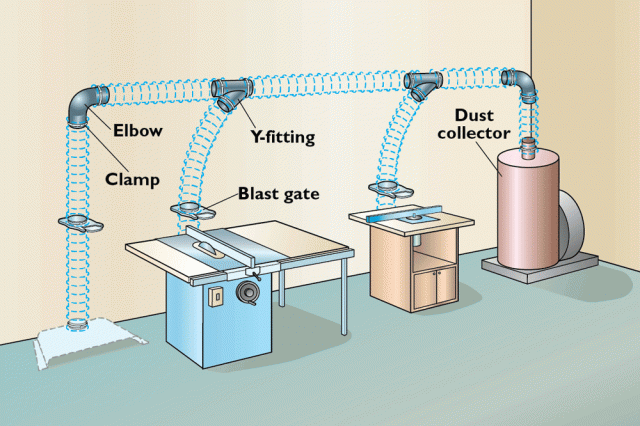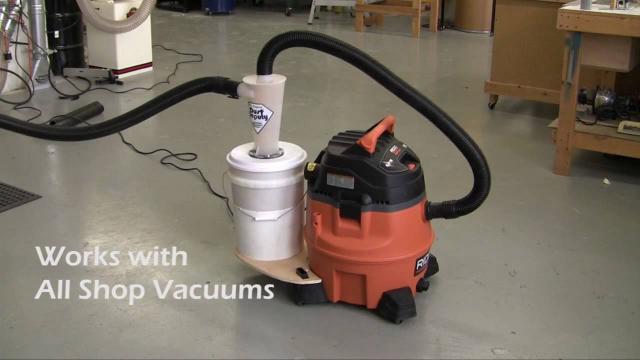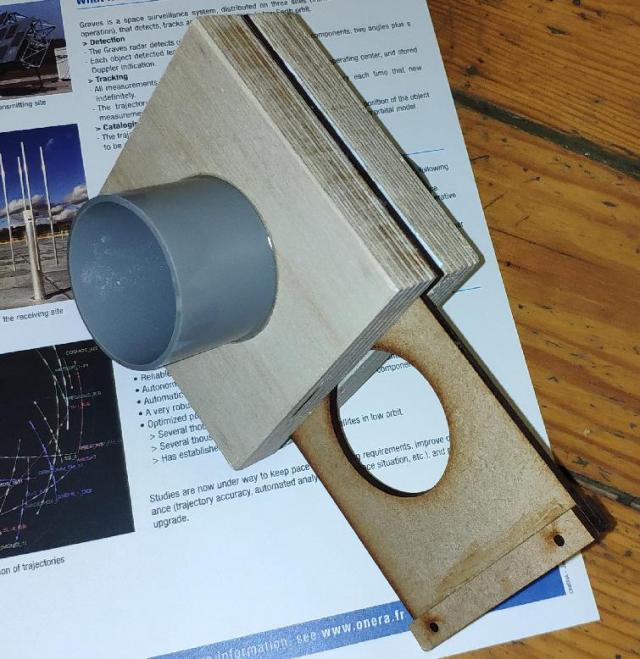A proposal of dust management system for the fablab of IMAL
Introduction
Dust generated by woodworking machines is typically a nuisance. The management and cleaning of the sawdust can be eased by using a dust management system. A possible realisation of such dust management system at the fablab of IMAL is detailed below. The drawing hereunder gives a schematic view of such system. The different components are discussed in the next sections.
Dust collector
This is a fancy name for a vacuum cleaner. However, most vacuum cleaners have either a filter or (worse) a bag that needs to be changed whenever it is full. By putting a dust separator ahead of the vacuum cleaner, most of the dust stays in the separator while the vacuum bag (or filter) collects a negligible amount of dust.
Such a dust separator consists of a cyclone, a kind of cone, that separates the (heavy) dust from the air. It has to be put on top of a sealed container (bucket) where the dust will fall by gravity. The cyclone itself can be bought for instance on aliexpress or amazon.de.
Blast gate
In order to concentrate the airflow on the machine that is actually used, the pipe going to unused machines has to be closed off. This is done using so-called blast gates. Blast gates can either be bought ready-made (e.g. on aliexpress, here for pipes with 50mm external diameter) or manufactured at the fablab (see picture).
Floor sweep
An additional bonus of such dust management system is that a floor sweep can be added, easing the collecting of the dust when sweeping the floor.
Pipes, elbows and Y-fittings
These can be made out of common PVC-tubing used for waste water. Ideally, the pipes would be transparent to ease unclogging if needed, but at a (much) higher cost.
The flexible tubing can best be bought from dedicated manufacturer (e.g. Norres, available on amazon.de). These tubes are antistatic (they are slightly conductive) and have a metallic armor, which can be used to ground the tubing. The flexible tubing can be fastened to the PVC-tubing using clamps (e.g. on aliexpress).
Example realisations
Showstoppers
The following showstoppers must be considered and dealt with
- fire risk: static electricity can build-up due to friction of the dust on the PVC tubing and produce arcing, igniting the dust in the container. The solution consists in 1) using antistatic (slightly conducting) tubing and 2) a grounding wire. Both eliminate the static electricity built-up.
- pressure losses (pertes de charge): the length of the tubing and the elbows induce friction that reduce the depression at the end of the tubing. Using smooth tubing and large-diameter tubes helps reduce the losses. Using corner with large radiuses (i.e. 2x45degrees instead of 1x90degrees) also helps.
- clogging: at places where the airflow is to low, dust can build-up, leading to a clogging of the piping. Reducing the diameter may help, at the expenses of larger pressure losses (see above). The classical solution however, is to have a larger diameter and a more powerful vacuum cleaner.
Way forward at the fablab @ IMAL
I would suggest a staged approach, i.e.,
- establish detailed bill of material
- build a dust separator based on a cyclone;
- build the connection to a first machine to evaluate the pressure losses and the effectivity of dust gates;
- connect more machines as experience is gained;
Info
Date: November 2019
Last updated: November 2019





